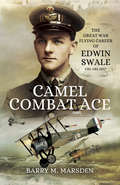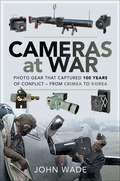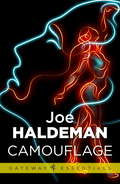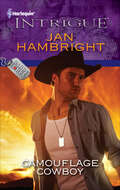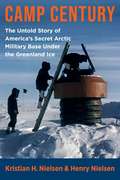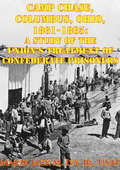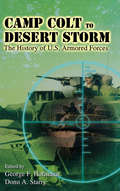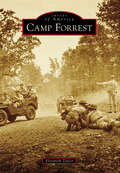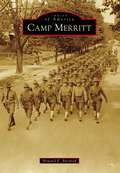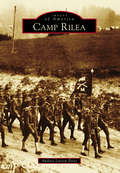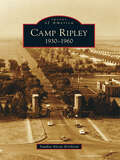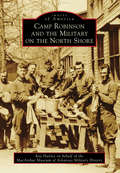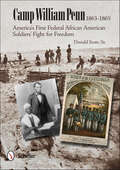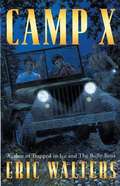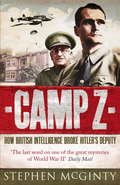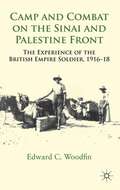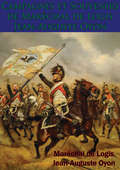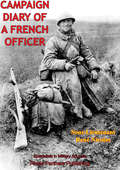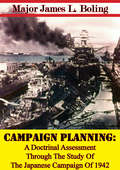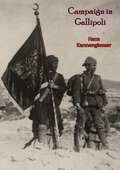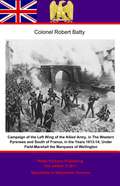- Table View
- List View
Camel Combat Ace: The Great War Flying Career of Edwin Swale CBE OBE DFC*
by Barry M. MarsdenA thrilling account of a World War I airman&’s service in the skies over the trenches: &“Well detailed and illustrated. . . . highly recommended.&” —Over the Front This book follows the First World War career of Captain (later wing commander) Edwin Swale, CBE DFC and bar, who served with 210 Squadron RAF, piloting Sopwith Camel scouts between March and October 1918. During this timeframe, he destroyed seventeen enemy aircraft, the majority being the formidable Fokker DV11. He undertook a series of perilous operations, including patrols, bombing and strafing missions, and bomber escorts. After the cessation of hostilities, he continued his flying career by piloting gliders over his native Derbyshire. He rejoined the RAF during the Second World War, and ended the conflict as an intelligence officer in charge of Ultra operations with the 2nd TAF. His legacy continued with his son Duncan, who also served in the RAF during the Second World War, flying low-level intruder operations in de Havilland Mosquitoes and earning a DFC and a US DFC—and he also left his mark on his native Chesterfield, where he served as mayor, among other prominent positions. This is his story, told in full and thrilling detail.
Camel Pilot Supreme: Captain D V Armstrong DFC
by Annette Carson&“Annette Carson has done a wonderful job of chronicling Armstrong&’s life, flight training and ultimate recognition as the undisputed master of aerobatics.&” —Over the Front Initially forbidden as foolhardy, stunt flying soon became a paramount method of survival in the life and death mêlées of dogfighting. But pilots still delighted in the joy and exuberance of aerobatting for its own sake, and they recognized a master of that very special skill in young D&’Urban Victor Armstrong, whose displays were nothing short of electrifying. Fluid and dramatic, performed with flair at ultra-low level, his exhibitions left spectators shaking their heads in disbelief. Until this book, little was known about Armstrong&’s wartime experiences, and even less about his South African background. His great value to the authorities lay in his superb handling of the Sopwith Camel, which upon its introduction had taken a heavy toll in fatal trainee accidents. While still on active service, Armstrong was sent around the units providing vivid proof that, properly handled, the stubby little fighter delivered the key to combat success: unrivaled maneuverability. His resultant fame eclipsed his other distinguished role in pioneering night flying and night fighting, an equally vital skill he was also detailed to demonstrate around the squadrons. In this &“superb biography,&” you will find yourself in the cockpit of the F.1 Camel and become acquainted with its rotary engine (Stand To!). You will meet many leading names including Billy Bishop, Cecil Lewis, Norman Macmillan, Robert Smith Barry, and the harum-scarum Three Musketeers from War Birds. Armstrong takes his place alongside them as one of the legendary figures of the first great aerial war.
Cameras at War: Photo Gear that Captured 100 Years of Conflict - From Crimea to Korea
by John WadeA comprehensive history of the development and use of cameras in recording British military conflicts from the 1850s to the 1950s.Books about war and the pictures that came out of conflict usually concentrate on the picture content. But behind every picture there is a camera—and that’s what this book is about. Profusely illustrated throughout with pictures of the cameras, rather than the pictures they took, it looks at one hundred years of conflict from the Crimean War to the Korean War. It begins in the days when a photographer needed to be more of a scientist than an artist, such were the difficulties of shooting and processing any photograph. It ends with the cameras whose compact dimensions, versatility and ease of use meant that photographers could largely forget the science and concentrate on the art. Some cameras simply recorded events. Others defined and changed the way those events proceeded. These were the cameras that went to war, and this is their story.Praise for Cameras at War“An amazing collection of superb photographs beginning with some from the Crimean War—coupled with a brilliant narrative that emphasizes the use of photography to record conflict. Where would we be without such evidentiary mementoes?” —Books Monthly (UK)
Camouflage (Gateway Essentials #346)
by Joe HaldemanWinner of the Nebula Award for best novel, 2005Winner of the James Tiptree, Jr. Award 2004Unknown to anyone, two creatures have wandered the Earth for generations. The aliens have no knowledge of each other, but share a residual memory of a mysterious, sunken relic - and an affinity for deep water. One, the changeling, has survived by adaptation, taking the shapes of many different organisms. The other, the chameleon, has survived solely by destroying anything or anyone that threatens it.Now, finally brought up from the bottom of the sea by marine biologist Russell Sutton, the relic calls to them both . . . to come home. For all these generations there have been two invincible creatures on Earth. But the chameleon has decided there's only room for one . . .
Camouflage Cowboy (Daddy Corps #5)
by Jan HambrightA single mother with a sick child was not something Agent Nick Cavanaugh was prepared to face. Unfortunately, his very special assignment included finding the woman and protecting her from learning the truth about his client and the vultures about to descend on her privacy. With no choice but to stick by Grace Marshall until all threats were neutralized, it took one little boy and his need for a cure no time at all to work their way into Nick's heart. Peeling back Grace's layers, Nick uncovers a mysterious past, and also a passion that stirs his soul and inflames his desire. As he struggles between what is dutiful and what is right, a killer unexpectedly makes his move....
Camouflage: Modern International Military Patterns
by Eric H. LarsonA comprehensive, accurate, and academically-supported reference of all of the major military and paramilitary camouflage patterns that have been in use around the world from the end of World War Two to today. This book will be a one-stop, generalized reference illustrating as many patterns as have been researched into the present time period. It will surpass all previous efforts. In addition to color tiles illustrating camouflage patterns it will include photographs of the designs actually being worn by military and paramilitary personnel, something few other references have done in suitable combination.
Camp Century: The Untold Story of America's Secret Arctic Military Base Under the Greenland Ice
by Henry Nielsen Kristian Hvidtfeldt NielsenAt the height of the Cold War, the United States Army secretly began work on a base embedded deep in the Greenland ice cap: Camp Century. Officially defined as a scientific research station, this facility had an undisclosed purpose: to aim up to 600 nuclear warheads, buried in the ice, at the Soviet Union. In 1966, just six years after the camp was established, the United States gave up this provocative strategy and abandoned the base. Despite its brief life, Camp Century has been the cause of controversies from diplomatic relations between the United States and its Arctic allies, Denmark and Greenland, to the risks of radioactive waste abandoned at the site.This book is the first comprehensive account of the U.S. Army’s “city under the ice.” Beginning with the Truman administration’s vision of military superiority in the Arctic and continuing through present-day concerns over the effects of climate change, Kristian H. Nielsen and Henry Nielsen unravel the extraordinary history of this clandestine installation. Drawing on sources including top-secret memos and never-before-seen photographic evidence, they follow the intertwining threads of high-level politics, ice-core research, media representations, daily life beneath the ice, and the specter of long-buried environmental problems that will one day resurface. Camp Century reveals a hidden chapter of Cold War history—and why, as the Greenland ice cap slowly melts, this story is not yet over.
Camp Chase, Columbus, Ohio, 1861-1865: A Study Of The Union's Treatment Of Confederate Prisoners
by Major Jack Morris Ivy Jr.Camp Chase, four miles southeast of Columbus, Ohio, began in May 1861 as a mustering center for units entering Union service during the American Civil War. By June 1861 it picked up additional responsibilities of housing Confederate prisoners captured by Ohio units during the earliest military actions of the war. It eventually expanded to hold 9,423 prisoners in Jan. 1865, which made it one of the larger Union prison camps.The earliest prisoners were afforded extraordinary leniency by state authorities until the Union government stepped in with rules and regulations. By Oct. 1862, an effective system was in place to secure and care for prisoners. Success continued despite fluxuations in prison population, disease and a constant influx of captured wounded, until Aug. 1864 when rations were reduced in retribution for Confederate treatment of Union captives.Ration reduction caused prisoners hardships but did not markedly increase mortality. Quality medical care and sanitation kept mortality below Union Army deaths from disease.As prison population soared during the last months of the war, increasing numbers of wounded, severely exposed and weakened captives joined Camp Chase. Reduced rations continued to pose hardships but ration reduction was offset by superb medical care and sanitation which continued to keep mortality below that experienced by the Union Army from disease....Prisoners were well treated up to the time rations were reduced in retaliation for alleged Confederate cruelities to Union prisoners. In spite of this, Camp Chase officials continued to stress sanitation and provide clothing late in the war even though they were not obligated to do so. This demonstrated that officials at Camp Chase were successful in managing a prisoner of war camp, even during the period of Union retaliation.
Camp Colt to Desert Storm: The History of U.S. Armored Forces
by George F. Hofmann and Donn A. StarryThis history of American armored warfare through the twentieth century &“boasts some of the best available analysis of mobile war as practiced by the US" (Publishers Weekly). Camp Colt to Desert Storm is the only complete history of US armed forces from the advent of the tank in battle during World War I to the campaign to drive Iraq out of Kuwait in 1991. With comprehensive analysis, it traces the development of doctrine for operations at the tactical and operational levels of war and assesses how this fighting doctrine translates into the development of equipment. Beginning with the Army&’s first tank school, Camp Colt in Gettysburg, Pennsylvania, this volume examines how armored warfare effected and was influenced by the evolution of twentieth-century combat. The tank revolutionized the battlefield in World War II. In the years since, developments such as nuclear weapons, ballistic missiles, computer assisted firing, and satellite navigation have continued to transform armored warfare&’s role in combat.
Camp Forrest (Images of America)
by Elizabeth TaylorCamp Forrest was a training, induction, and combatant prisoner-of-war (POW) facility located on the outskirts of Tullahoma, Tennessee. It was a self-sustaining city where over 70,000 soldiers were stationed and approximately 12,000 civilians were employed throughout World War II. In 1942, the camp transitioned to an enemy alien internment camp and was one of the first civilian internment camps in the United States. By the middle of 1943, it had transitioned into a POW camp and housed primarily German and Italian prisoners. After the war ended, the base was decommissioned and dismantled in 1946. In 1951, the area was recommissioned and expanded into the US Air Force's Arnold Engineering Development Complex. Few remains of this important World War II facility exist today; however, the images within provide a glimpse into the effects and realities of a global war on American soil.
Camp Merritt (Images of America)
by Howard E. BartholfCamp Merritt, located in Bergen County, New Jersey, was authorized by the federal government in August 1917 as a critically needed embarkation base for processing US Army soldiers bound for the battlefields of Europe during World War I. The site of the camp, which now encompasses parts of five towns, was chosen for its proximity to roadways, railroads, and the Hudson River, which enabled the rapid movement of large numbers of troops and equipment to the nearby shipping port of Hoboken. As the war progressed, the size and scope of the base expanded; it was closed on June 30, 1920. During its lifetime, the camp processed over one million soldiers and nurses both going to and returning from war zones.
Camp Rilea (Images of America)
by Andrea Larson PerezCamp Rilea, originally named Camp Clatsop, was founded in 1927 and soon became the Oregon National Guard's preferred training site--a claim that still holds true today. Located on the picturesque Oregon coast in the town of Warrenton, near Astoria, Camp Rilea covers 1,800 acres and includes three miles of Pacific coast beachfront. The historical photographs in this book tell a fascinating story of the important role Camp Rilea has played over time to all who have passed its gates for generations. Since the early days, Camp Rilea Armed Forces Training Center sealed its reputation as the premier regional location offering maneuver areas, facilities, and ranges supporting myriad military units, law enforcement agencies, and public safety and utility-related organizations. A valued community partner, Camp Rilea also hosts many civic and social events, including sports camps, track and field competitions, and Boy Scout gatherings. Come see what really happens "behind the dune" at Camp Rilea.
Camp Ripley: 1930-1960 (Images of America)
by Sandra Alcott EricksonCamp Ripley is the successor to Minnesota's first formally established National Guard training facility, Camp Lakeview, which was located on the shores of Lake Pepin and south of the town of Lake City. The new post took its name from Fort Ripley, a U.S. Army frontier fort that opened in 1849. The fort's original site with its remaining ruins are encompassed within the current boundaries of theCamp Ripley Military Reservation. Since the camp was expanding its facilities during the Great Depression, numerous individuals employed by federal New Deal programs participated in the building of Camp Ripley. In words and images, Camp Ripley: 1930-1960 documents the history of the camp during the first three decades of its existence. The images in this book have been selected from the archives of the Minnesota Military Museum as well as the Minnesota Department of Military Affairs and private collections.
Camp Roberts (Images of America)
by California Center for Military HistoryCamp Roberts, in the Salinas Valley, is one of California's largest military training camps. Named for a heroic World War I tank driver, it took the threat of global war in 1940 to kick-start its construction. Soon Camp Roberts had a capacity to house and train 23,000 men. During the war, almost half a million men trained here. Row upon row of wooden buildings, replete with churches, stores, a hospital, and an amphitheater where A-list stars performed, made it a mobilized city of 45,000 at its peak. In 1946, it became a ghost town overnight. Revived during the Korean and Vietnam conflicts, it passed into National Guard control in 1971. However, all branches of the military continue to train here, and the camp has renewed relevance for troops bound for the Middle East.
Camp Robinson and the Military on the North Shore (Images of America)
by Ray Hanley MacArthur Museum of Arkansas Military HistoryArkansas has always been among the leading states whose people stepped up to defend the nation in times of war. On a few thousand acres of land across the Arkansas River from the capital city of Little Rock, this dedication is evident. Images of America: Camp Robinson and the Military on the North Shore traces the area's military history from the founding of Fort Logan H. Roots in the late 1800s through the training for World War I and World War II, when as many as 50,000 men and women were stationed at Camp Robinson at any one time. This book pays tribute to the Arkansas National Guard, which is still based at Camp Robinson and has served countless times in times of war and natural disasters. Illustrated with rare photographs spanning more than a century, Camp Robinson and the Military on the North Shore commemorates one of the proudest military training grounds in the nation's history.
Camp Tyson: The Story Of Camp Tyson - America's Only Barrage Balloon Training Facility (Images of America)
by Shannon McfarlinIn 1941, Paris, Tennessee, became the home of Camp Tyson. The 2,000-acre camp named for Knoxville World War I veteran Brig. Gen. Lawrence Tyson was built by some 800 laborers and consisted of 450 buildings including barracks, a hospital, and a theater. Over the course of World War II, the camp grew to about 6,000 acres in size and served as a training ground for as many as 25,000 servicemen, as well as a POW camp for many Germans and Italian prisoners. At Camp Tyson, soldiers trained to construct, maintain, and operate barrage balloons. These balloons were successfully used to provide anti-aircraft protection during World War I and again in World War II with the help of those trained in Henry County. However, the atomic bomb made barrage balloons obsolete, and after the war, Camp Tyson was decommissioned.
Camp William Penn: 1863–1865
by Donald Scott Sr.The first Civil War facility to exclusively train federal black soldiersPhiladelphia and Camp William Penn hosted the greatest anti-slavery abolitionists and Underground Railroad of that centuryOver 130 rare images
Camp X
by Eric Walters12-year-old George and his brother Jack are spending wartime summer while their dad is off fighting the Germans. One afternoon, the boys stumble across Canada's top-secret spy camp and so begins an exciting and terrifying adventure as both get caught up in the covert activities of Camp X.
Camp Z: How British Intelligence Broke Hitler's Deputy
by Stephen McGintyOn 10 May 1941, Rudolf Hess, then the Deputy Führer, parachuted over Renfrewshire in Scotland on a mission to meet with the Duke of Hamilton, ostensibly to broker a peace deal with the British government. After being held in the Tower of London, he was transferred to Mytchett Place near Aldershot on 20 May, under the codename of 'Z'. The house was fitted with microphones and sound recording equipment, guarded by a battalion of soldiers and codenamed 'Camp Z'.Churchill's instructions were that Hess should be strictly isolated, with every effort taken to get any information out of him that could help change the course of the Second World War. Stephen McGinty uses documentation, contemporaneous reports, diaries, letters and memos to piece together a riveting account of the claustrophobia, paranoia and high-stakes gamesmanship being played out in an English country house. CAMP Z is a 'locked room mystery' where the 'locked room' is a man's mind that no one can conclude, with any degree of confidence, is sane.
Camp and Combat on the Sinai and Palestine Front
by Edward C. WoodfinDunes, sandstorms, freezing crags and searing heat; these are not the usual images of World War I. For many men from all over the British Empire, this was the experience of the Great War. Based on soldiers' accounts, this book reveals the hardships and complexity of British Empire soldiers' lives in this oft-forgotten but important campaign.
Campagnes et Souvenirs de Maréchal de Logis Jean-Auguste Oyon
by Maréchal de Logis Jean-Auguste Oyon« Ulm et Austerlitz, le Portugal en 1807 et en 1808, Laon en 1814. Les amours de l'auteur occupent une place aussi importantes dans ses souvenirs que ses exploits militaires. » p 129 - Professeur Jean Tulard, Bibliographie Critique Sur Des Mémoires Sur Le Consulat Et L'Empire, Droz, Genève, 1971
Campaign Diary Of A French Officer
by Katherine Babbitt Lieutenant Nicolas René"A CAMPAIGN DIARY, do you say, Reader? If the original were before you, you would not find it, like these printed pages, clean and whole. On it are the marks of war - bloodstains and smears of mud, and, from cover to cover, a hole made by a tiny piece of steel. These you may not see, but for the rest no change has been made. The author is presenting to you his notes just as he set them down at the front. The facts are true, though the form is brief, almost impersonal, and entirely without the literary flourishes that it would have been so easy to add après coup."He is very young, this French officer. When the war broke out he was still at the university, a member of that inner circle of the École Normale Supérieure, where he was completing his studies in literature. After the mobilization, he qualified rapidly for an officer's commission and started for the front. His first months there were spent in the mud and desolation of that barren plain known as la Champagne Pouilleuse. They were months made difficult by frequent skirmishes with the Boches, and by a constant struggle with that other and more relentless enemy - the mud of Champagne. In April, 1915, his regiment left the trenches, and crossed on foot, by daily stages, the great Forest of Argonne, all fragrant with the spring. We meet him again early in May before Arras, on the eve of the Artois offensive. Only the beginning of this offensive is described in the Diary. On May 9th, he fell, seriously wounded, between the French and German lines, ten yards from the enemy's trench. He himself will describe to you that terrible day and his agonizing return to the French positions....If, among these pages, there are some that for a moment make you feel the horror and the thrill of war, then say to yourself, Reader, it is not one man alone who has thought these thoughts and endured these sufferings. It is the history of the youth of a whole nation."-L. PLANTEFOL, Paris, 1917
Campaign Planning: A Doctrinal Assessment Through The Study Of The Japanese Campaign Of 1942
by Major James L. BolingThis thesis analyzes the political role of the German General Staff as well as civil military relations in Germany from the late 19th century until 1933. Specifically, it examines the rise and fall of Kurt von Schleicher. Together with Generals Paul von Hindenburg, Erich Ludendorff, and Wilhelm Groener, Schleicher shaped the politics of the Weimar Republic, right up to the end that he--unintentionally--hastened when his intrigues paved the way for Adolf Hitler's dictatorship.During World War I, the German army completed its control over the civilian administration and bureaucracy. In the Republic of Weimar 1919-1933, the military remained a powerful governmental player--as the self-anointed protector of the nation against external and internal threats, including democracy.Thus, Germany's political situation in the winter of 1932-1933 and the activities of the key players stemmed from a long-term anti-democratic socialization process amid an entrenched civil-military imbalance. As the present thesis demonstrates, Schleicher's life--from his military background to his experience as a member of Prussia's noble Junker class--coincided with Germany's tumultuous modernization. The fateful lessons that he drew from this experience ultimately spelled the end of Germany's first democracy and ushered in the calamity of the Third Reich.
Campaign in Gallipoli
by Hans KannengiesserHans Kannengiesser’s Campaign in Gallipoli is a riveting firsthand account of one of World War I’s most infamous and hard-fought campaigns, offering a unique perspective from the German officer who played a key role in defending the Ottoman Empire’s positions against Allied forces. This book provides an in-depth analysis of the military strategies, the grueling conditions, and the immense human cost of the Gallipoli Campaign, as seen through the eyes of a commander on the ground.Kannengiesser, who served as a German military advisor and commander of Ottoman forces, recounts the intense battles that unfolded on the rugged cliffs and beaches of Gallipoli. He provides detailed descriptions of the defensive operations, the coordination between German and Ottoman forces, and the challenges they faced against a determined Allied assault. His narrative sheds light on the strategic significance of the Dardanelles, the difficulties of trench warfare, and the resourcefulness required to hold the line in the face of overwhelming odds.Beyond the battlefield, Kannengiesser reflects on the broader implications of the campaign, including the cultural dynamics of working alongside Ottoman troops and the ultimate failure of the Allied effort to secure the region. His account combines military analysis with personal observations, making it a valuable resource for understanding the complexities of this pivotal moment in history.Campaign in Gallipoli is an essential read for military historians, World War I enthusiasts, and anyone interested in gaining a deeper understanding of one of the conflict’s most iconic and tragic campaigns. Kannengiesser’s detailed and candid account offers a rare glimpse into the perspective of those tasked with defending Gallipoli, making this book a timeless addition to the literature of the Great War.
Campaign of the Left Wing of the Allied Army, in The Western Pyrenees and South of France, in the Years 1813-14; Under Field-Marshall the Marquess of Wellington.
by Pickle Partners Publishing Colonel Robert BattyThis ebook is purpose built and is proof-read and re-type set from the original to provide an outstanding experience of reflowing text for an ebook reader. Robert Batty, wrote a number of books on his battlefield experiences as a young subaltern, in the 1st battalion Grenadier Guards during the Napoleonic wars, notably this volume concerning the period 1813-1814. Even leaving studies in medicine at Ciaus College Cambridge in order to join the British Army. He served through out the campaigns in 1814 and also at Waterloo, achieving the rank of Colonel below leaving the service. An acclaimed artist who was to exhibit his work widely and became a Fellow of the Royal Society, his artistic eye is to the fore in these memoirs. Unlike some of his contemporaries he is honest enough to disclaim the attempt to describe those events that he did not witness, which leads to an uncommon reliability. He describes the siege of San Sebastian, and the advance of the Allied army as it outflanked each successive river position that the courageous French under Marshal Soult attempted to bar the way in excellent detail. The battles of Bayonne and Toulouse are pictured vividly. Author- Colonel Robert Batty [????-1848] of the First, or Grenadier, Guards, F.R.S.; Member of the Imperial Russian Order of St. Anne. Text taken, less watercolour pictures, from the 1823 edition, published in London by John Murray. Original - 338 pages. Linked TOC
